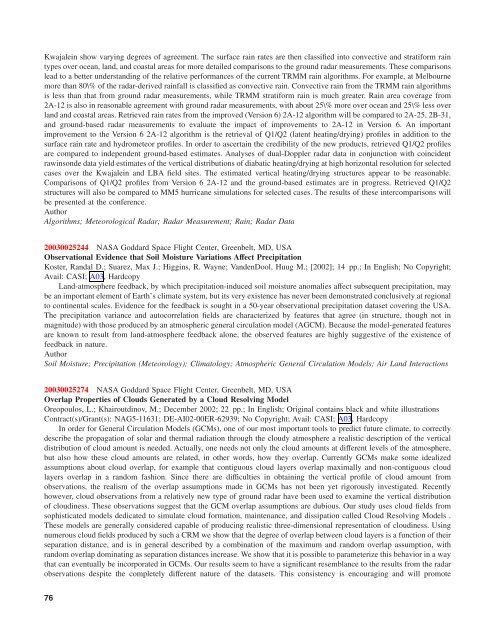You also want an ePaper? Increase the reach of your titles
YUMPU automatically turns print PDFs into web optimized ePapers that Google loves.
Kwajalein show varying degrees of agreement. The surface rain rates are then classified into convective and stratiform rain<br />
types over ocean, land, and coastal areas for more detailed comparisons to the ground radar measurements. These comparisons<br />
lead to a better understanding of the relative performances of the current TRMM rain algorithms. For example, at Melbourne<br />
more than 80\% of the radar-derived rainfall is classified as convective rain. Convective rain from the TRMM rain algorithms<br />
is less than that from ground radar measurements, while TRMM stratiform rain is much greater. Rain area coverage from<br />
2A-12 is also in reasonable agreement with ground radar measurements, with about 25\% more over ocean and 25\% less over<br />
land and coastal areas. Retrieved rain rates from the improved (Version 6) 2A-12 algorithm will be compared to 2A-25, 2B-31,<br />
and ground-based radar measurements to evaluate the impact of improvements to 2A-12 in Version 6. An important<br />
improvement to the Version 6 2A-12 algorithm is the retrieval of Q1/Q2 (latent heating/drying) pro<strong>file</strong>s in addition to the<br />
surface rain rate and hydrometeor pro<strong>file</strong>s. In order to ascertain the credibility of the new products, retrieved Q1/Q2 pro<strong>file</strong>s<br />
are compared to independent ground-based estimates. Analyses of dual-Doppler radar data in conjunction with coincident<br />
rawinsonde data yield estimates of the vertical distributions of diabatic heating/drying at high horizontal resolution for selected<br />
cases over the Kwajalein and LBA field sites. The estimated vertical heating/drying structures appear to be reasonable.<br />
Comparisons of Q1/Q2 pro<strong>file</strong>s from Version 6 2A-12 and the ground-based estimates are in progress. Retrieved Q1/Q2<br />
structures will also be compared to MM5 hurricane simulations for selected cases. The results of these intercomparisons will<br />
be presented at the conference.<br />
Author<br />
Algorithms; Meteorological Radar; Radar Measurement; Rain; Radar Data<br />
20030025244 NASA Goddard Space Flight Center, Greenbelt, MD, USA<br />
Observational Evidence that Soil Moisture Variations Affect Precipitation<br />
Koster, Randal D.; Suarez, Max J.; Higgins, R. Wayne; VandenDool, Huug M.; [2002]; 14 pp.; In English; No Copyright;<br />
Avail: CASI; A03, Hardcopy<br />
Land-atmosphere feedback, by which precipitation-induced soil moisture anomalies affect subsequent precipitation, may<br />
be an important element of Earth’s climate system, but its very existence has never been demonstrated conclusively at regional<br />
to continental scales. Evidence for the feedback is sought in a 50-year observational precipitation dataset covering the USA.<br />
The precipitation variance and autocorrelation fields are characterized by features that agree (in structure, though not in<br />
magnitude) with those produced by an atmospheric general circulation model (AGCM). Because the model-generated features<br />
are known to result from land-atmosphere feedback alone, the observed features are highly suggestive of the existence of<br />
feedback in nature.<br />
Author<br />
Soil Moisture; Precipitation (Meteorology); Climatology; Atmospheric General Circulation Models; Air Land Interactions<br />
20030025274 NASA Goddard Space Flight Center, Greenbelt, MD, USA<br />
Overlap Properties of Clouds Generated by a Cloud Resolving Model<br />
Oreopoulos, L.; Khairoutdinov, M.; December 2002; 22 pp.; In English; Original contains black and white illustrations<br />
Contract(s)/Grant(s): NAG5-11631; DE-AI02-00ER-62939; No Copyright; Avail: CASI; A03, Hardcopy<br />
In order for General Circulation Models (GCMs), one of our most important tools to predict future climate, to correctly<br />
describe the propagation of solar and thermal radiation through the cloudy atmosphere a realistic description of the vertical<br />
distribution of cloud amount is needed. Actually, one needs not only the cloud amounts at different levels of the atmosphere,<br />
but also how these cloud amounts are related, in other words, how they overlap. Currently GCMs make some idealized<br />
assumptions about cloud overlap, for example that contiguous cloud layers overlap maximally and non-contiguous cloud<br />
layers overlap in a random fashion. Since there are difficulties in obtaining the vertical pro<strong>file</strong> of cloud amount from<br />
observations, the realism of the overlap assumptions made in GCMs has not been yet rigorously investigated. Recently<br />
however, cloud observations from a relatively new type of ground radar have been used to examine the vertical distribution<br />
of cloudiness. These observations suggest that the GCM overlap assumptions are dubious. Our study uses cloud fields from<br />
sophisticated models dedicated to simulate cloud formation, maintenance, and dissipation called Cloud Resolving Models .<br />
These models are generally considered capable of producing realistic three-dimensional representation of cloudiness. Using<br />
numerous cloud fields produced by such a CRM we show that the degree of overlap between cloud layers is a function of their<br />
separation distance, and is in general described by a combination of the maximum and random overlap assumption, with<br />
random overlap dominating as separation distances increase. We show that it is possible to parameterize this behavior in a way<br />
that can eventually be incorporated in GCMs. Our results seem to have a significant resemblance to the results from the radar<br />
observations despite the completely different nature of the datasets. This consistency is encouraging and will promote<br />
76
















